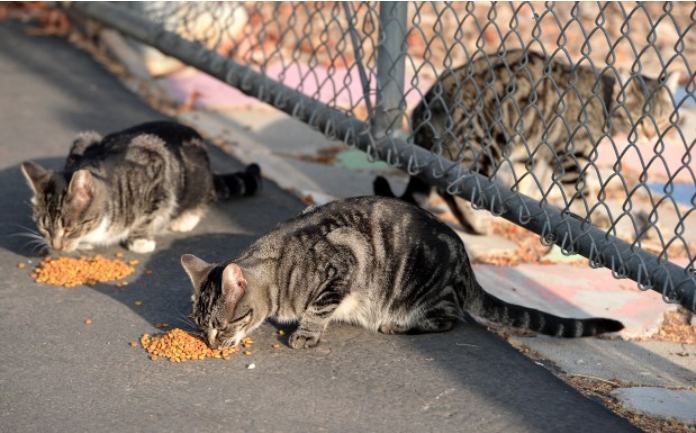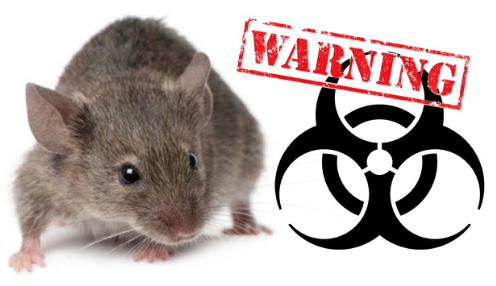CommentsANIMAL WATCH-Council President Herb Wesson last week admitted to replacing carpet in his office with laminate because of vermin infestation, but jokingly suggested employees be subjected to "an army of cats" to rid Los Angeles City Hall of rats (the four-legged ones.)
Mayor Eric Garcetti is in denial -- he told reporters recently that he hasn't seen any new rats since 2001! But, of course, he hasn't been here much lately. He also doesn't want to be "distracted" from the homeless situation by reports of fleas.
The above is evidence of the obvious inability of Los Angeles' highest elected officials to deal with a critical reality in Los Angeles.
 The fact that Wesson would even joke about passing off the public-health crisis to "an army" of feral cats based upon the advocacy of one animal-rights group -- rather than follow the advice e of the County Health Department experts, who warned that the fleas would just jump on the cats also -- demonstrates the contempt Los Angeles' city government officials have for voters who continually reward their incompetence and disdain with re-election.
The fact that Wesson would even joke about passing off the public-health crisis to "an army" of feral cats based upon the advocacy of one animal-rights group -- rather than follow the advice e of the County Health Department experts, who warned that the fleas would just jump on the cats also -- demonstrates the contempt Los Angeles' city government officials have for voters who continually reward their incompetence and disdain with re-election.
It's the political version of domestic violence, in which they have come to believe we deserve and enjoy their abuse.
It's time to fight back -- typhus is serious and toxoplasmosis can be deadly to certain victims, and City Hall doesn't care.
CATS AND TOXOPLASMOSIS -- A SERIOUS HEALTH/SAFETY RISK
Last week in CityWatch, we discussed "Suicides by Veterinarians Increasing in 'No Kill' Era." The seriousness of the individual situations did not make it an appropriate venue to add that some scientists have concerns that constant exposure to cat feces and toxoplasmosis could be a contributing factor in this tragic phenomenon.
Toxoplasmosis is an infection caused by a single-celled parasite, called Toxoplasma gondii. The Toxoplasma parasite can persist for long periods of time in the bodies of humans (and other animals), possibly even for a lifetime.
Most people who become infected are not aware of it because they have no identifiable symptoms. Some may feel as if they have the “flu,” with swollen lymph glands or muscle aches and pains that may last for a month or more.
But, severe toxoplasmosis, causing damage to the brain, eyes, or other organs, can develop from an acute infection or one that had occurred earlier in life and is now reactivated. It is more likely in individuals who have weak immune systems, though occasionally, even persons with healthy immune systems may experience eye damage from toxoplasmosis.
Those most likely to be infected are infants born to mothers who are newly infected with Toxoplasma gondii during or just before pregnancy; and persons with severely weakened immune systems, such as individuals with AIDS, those taking certain types of chemotherapy, and those who have recently received an organ transplant.
Although there are other sources, the CDC lists one of the most common sources of Toxoplasmosis as: accidentally swallowing the parasite through contact with cat feces. This might happen by cleaning a cat’s litter box when the cat has shed Toxoplasma in its feces; or touching or ingesting anything that has come into contact with cat feces that contain Toxoplasma.
THE LINK BETWEEN HUMANS, CATS AND TOXOPLASMA
It has been found that the Toxoplasma gondii parasite is capable of changing the brains of whatever organism it infests. A new study explored rats’ response to cat urine. Rats and mice are naturally repulsed by cat urine as a basic survival instinct. However, researchers in a recent study found that when rats and mice with T. gondii infection were exposed to cat urine, they showed activity in brain areas associated with sexual arousal instead, according to Healthland.Time.com.
This caused them to lose their fear of cats and actually be attracted to cat urine and thus more vulnerable to being caught by the cat. Dr. Joanne Webster coined the phrase “fatal feline attraction” to describe this behavior. She observed that rats and mice infected with Toxoplasma start wandering around and behaving in ways that will bring them to the attention of cats.
THE LINK BETWEEN HUMANS, CATS AND TOXOPLASMA
- gondii, or Toxoplasma, can be transmitted to, and live in, almost any warm-blooded mammal, but, since it reproduces sexually only in the intestines of cats, it is in the parasite’s genetic interest to be ingested by cats. Being able to manipulate the behavior of rats — cat’s most likely prey — can guarantee the parasite’s survival and proliferation.
It has been found that T. gondii can also alter the thinking patterns of humans. Research in the 1950s found that this parasite infection in humans may affect personality and possibly even the risk of schizophrenia. Some symptoms of schizophrenia are those which describe the bizarre hoarding and hiding behavior of the “cat ladies”; i.e., trouble keeping friends, anxiety, depression and suicidal thoughts, isolation, and delusions -- strongly held beliefs that are not real. (Such as not seeing that animals are suffering and dying from your actions.).
THE CURRENT HAZARD AT CITY HALL -- FLEA-BORNE TYPHUS
Flea-borne typhus is a disease that infected fleas can spread to humans. Bacteria found in infected fleas, and their feces, cause typhus.
Fleas can come from many types of animals including cats, rats, and opossums.
Lest we forget, Wesson presides over the Council that proudly approved Councilmember Paul Koretz (who boasts about having 19 cats as a child) and Valley Councilman Bob Blumenfield's proposal to spend $800,000 in tax funds for a report that will allow circumventing a court injunction which prohibits tax money from being spent to spay/neuter and release feral (wild) cats and allow them to be fed on public land.
The City also intends to prohibit owners from removing feral cats from their residential or commercial property. This means the typhus and toxoplasmosis threats experienced in City Hall can spread citywide without interference.
RATS, FLEAS ACCEPTED GARCETTI'S INVITE TO "OCCUPY LA"
Remember October 2011 when a beaming City Council President Garcetti bustled out the door of City Hall, stood with open arms and proclaimed to dozens of "Occupy LA" tent dwellers on the front lawn: “Stay as long as you need, we’re here to support you.”
Taxpayers were not consulted.
Soon the gorgeous green grass was brown and strewn with needles, discarded food and containers. The entire block smelled like urine, feces and decaying food. Fearful civic center visitors and workers avoided the immediate area whenever possible. It was chillingly obvious city officials had lost control.
Finally, Garcetti turned the monster he had created over to the LAPD to clean up. LAPD moved the homeless humans off the lawn and onto the sidewalk, where they began permanent residency. The rats stayed.
NORWAY (GUTTER) RATS VS. BLACK (ROOF) RATS
As an adult, the Norway Rat can weigh between 12 and 16 oz. with a body length of 6-8 inches long.
Norway rats are primarily nocturnal and tend to remain in hiding during the day. Unlike roof rats, they prefer to inhabit sewers and the lower floors of multi-story buildings in urban areas.
They live very close to people and normally nest in burrows that are found along building foundations, beneath wood piles, rubbish in the gardens and fields.
They thrive in the sanitary sewer system feeding on human wastes. They have been known to come up toilets inside the buildings and exit the sanitary sewer systems through sewer breaks. (Source: Alameda County Dept. of Environmental Health.)
Roof rats are smaller and tend to seek shelter on roof tops and in attics, where they may chew through walls, insulation, pipes and wires.
Both the Norway Rat and the roof rat can also spread disease through their droppings and urine, including plague, murine typhus, jaundice, leptospirosis and Weil’s disease.
TOXOPLASMOSIS AND TYPHUS ARE NOT VIDEO GAMES
A letter in the LA Times on February 13, 2019 describes the experience of a couple living in Reseda, who both contracted typhus last year, and attributed it to a neighbor who is a hoarder and "whose backyard is home to countless rodents and other critters." The letter says they received no response from LA city departments when they requested help in addressing the unsanitary conditions.
MEGAN DAUM, LA Times Reporter (Survivor of Typhus)
In October of 2010 I woke up one night with a fever. Though I’d wondered for the previous few days if I might be coming down with a cold, the chills and 102 temperature seemed to come out of nowhere.
The next day my body ached as though I’d fallen down a flight of stairs. I was unbearably and unquenchably thirsty and too tired to get out of bed. Figuring I had the flu, I kept the fever at bay for a few days with aspirin but continued to get sicker. Nausea and back pain added themselves to the list of symptoms.
By the time I went to the doctor I could barely walk, my blood pressure was shockingly low and my eyes were turning yellow. I was sent to the hospital and the last thing I remember was trying to speak to the doctor but not being able to get words out. I was slurring my speech and talking gibberish. I didn’t know the date or who the president was. I woke in the ICU up four days later.
DISPELLING THE MYTHS ON TRANSMISSION OF TYPHUS
-- Flea-borne typhus (also called 'murine typhus) is endemic--meaning it is always present.
-- It is a disease that infected fleas can spread to humans. Bacteria (Rickettsia typhi and R. felis) found in infected fleas, and their feces, cause typhus.
-- Pets and other animals do NOT get sick from typhus. They, therefore, cannot be inoculated (vaccinated) against it.
-- Fleas can come from many types of animals including cats, rats, and opossums.
-- Typhus is not transmitted person-to-person.
-- Typhus can cause high fever, chills, headache, and rash in people and can be treated with antibiotics.
The risk of typhus is increased where there is an accumulation of trash that attract wild animals like feral cats, rats and opossums that may carry an infected flea.
EXPERT'S DESCRIPTION OF FLEAS THAT CAUSE TYPHUS (Technical)
There are two different cycles of typhus that involve different flea species and different bacteria species.
RAT FLEAS
Typhus is caused by Rickettsia typhi, which is carried by the rat flea, Xenopsylla cheopis. This is what was traditionally recognized as typhus.
The distribution of the rat flea and R. typhii is limited by the rat nests. The fleas live in the nests and attach to the rats when they are feeding.
Rat fleas don’t preferentially bite people, but they will do so. The rat flea can be on either Norway rats (Rattus norvegicus) or black rats (Rattus rattus) but needs specific conditions in the nest to survive.
I’ve been told that Norway rat nests/burrows in Los Angeles provide good habitat for rat fleas, but that Rattus rattus (black rats) do not have nests with similar suitable conditions for rat fleas.
CAT FLEAS
In 1990 scientists discovered a second type of bacteria that causes typhus symptoms: Rickettsia felis. This bacteria species is associated with the cat flea Ctenocephalides felis, which is found on cats, opossums, rats, and other mammals and will readily bite humans.
It turns out this second form of Rickettsia can also infect rat fleas. This cat/opossum-flea-human route of infection is known from southern California and Texas and is referred to as the suburban cycle.
In the studies that are outside of areas with Norway rats, it looks like the transmission of typhus comes from cat fleas and R. felis instead of rat fleas and R. typhii. This means that free-roaming cats, high opossum density, and rats all contribute to risk of human infection.
TYPHUS BACTERIA IN LA CITY HALL/SKID ROW LIKELY CAUSED BY CATS/OPOSSUMS
I have not seen any evidence of which typhus bacteria caused the City Hall/Skid Row outbreak in Los Angeles. It is possible that it was R. felis, in which case the bigger problem than rats would be cats and opossums.
That is certainly the case elsewhere in Los Angeles like the San Fernando Valley and San Gabriel Valley — typhus caused by R. felis carried by cat fleas promoted by cats and opossums at high densities.
TYPHUS IN CITY HALL IS A REALITY NOW
Los Angeles Deputy City Attorney Liz Greenwood has suffered for two months from typhus she believes she got at work. She was working on the sixth floor of the 18-story City Hall East building. Greenwood said the presence of rats was long known. She has been out of work since November recuperating from the disease.
It has taken two months for City officials to even acknowledge her illness is related to the unhealthy conditions which she wants corrected for ALL City employees.
She is to be thanked and commended for her bravery in taking her story to the media and demanding action, but until it got public attention, she was ignored and left to suffer without the help of the city officials, including City Attorney Mike Feuer, who should have acted immediately to call in public health officials.
It sounds like much more than Herb Wesson's carpeting should be removed from City Hall.
(Phyllis M. Daugherty is a contributor to CityWatch and a former Los Angeles City employee.) Edited for CityWatch by Linda Abrams.

















